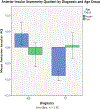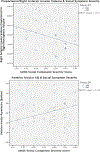Altered Anterior Insular Asymmetry in Pre-teen and Adolescent Youth with Autism Spectrum Disorder
- PMID: 34263174
- PMCID: PMC8277119
- DOI: 10.18314/abne.v1i1.1120
Altered Anterior Insular Asymmetry in Pre-teen and Adolescent Youth with Autism Spectrum Disorder
Abstract
Autism Spectrum Disorder (ASD) is hallmarked by social-emotional reciprocity deficits. Social-emotional responding requires the clear recognition of social cues as well as the internal monitoring of emotional salience. Insular cortex is central to the salience network, and plays a key role in approach-avoidance emotional valuation. Consistent right anterior insular hypoactivity and variable volumetric differences of insular cortical volumes were shown previously. The current study analyzed anterior and posterior insular volume/asymmetry changes in ASD across age. Age was used as an additional grouping variable as previous studies indicated differential regional volume in ASD individuals before and after puberty onset. In the current sample, pre-teen ASD expressed left lateralized anterior insula, while adolescent ASD had right lateralization. Typically developing (TD) individuals expressed the opposite lateralization of anterior insula in both age-groups (right greater than left anterior insular volume among pre-teen TD and left greater than right anterior insular volume among adolescent TD). Social-emotional calibrated severity scores from the ADOS were positively correlated with leftward anterior insular asymmetry and negatively correlated with proportional right anterior insular volumes in ASD. Insular cortex has a lateralized role in autonomic nervous system regulation (parasympathetic control in the left, sympathetic control in the right). Atypical insular asymmetry in ASD may contribute to the development of networks with a diminished salience signal to human faces and voices, and may lead to more learned passive avoidant responses to such stimuli at younger ages, leading to more distressed responses in adolescence. Data here supports the use of early behavioral intervention to increase awareness of and reward for social-emotional cues.
Keywords: Asymmetry; Autism; Autonomic nervous system; Development; Insular cortex; Morphometry.
Conflict of interest statement
Conflicts of Interest: Jeremy D Cohen declares he has no conflict of interest. Taylor Smith declares she has no conflict of interest. Khalil Thompson declares he has no conflict of interest. Armond Collins declares he has no conflict of interest. Tracey A. Knaus declares she has no conflict of interest. Helen Tager-Flusberg declares she has no conflict of interest.
Figures


Similar articles
-
Insular pathology in young people with high-functioning autism and first-episode psychosis.Psychol Med. 2017 Oct;47(14):2472-2482. doi: 10.1017/S0033291717000988. Epub 2017 Apr 24. Psychol Med. 2017. PMID: 28436341
-
Altered functional organization within the insular cortex in adult males with high-functioning autism spectrum disorder: evidence from connectivity-based parcellation.Mol Autism. 2016 Oct 5;7:41. doi: 10.1186/s13229-016-0106-8. eCollection 2016. Mol Autism. 2016. PMID: 27713815 Free PMC article.
-
Abnormal functional connectivity of the reward network is associated with social communication impairments in autism spectrum disorder: A large-scale multi-site resting-state fMRI study.J Affect Disord. 2024 Feb 15;347:608-618. doi: 10.1016/j.jad.2023.12.013. Epub 2023 Dec 7. J Affect Disord. 2024. PMID: 38070748
-
The insular cortex, autonomic asymmetry and cardiovascular control: looking at the right side of stroke.Clin Auton Res. 2024 Dec;34(6):549-560. doi: 10.1007/s10286-024-01066-9. Epub 2024 Sep 24. Clin Auton Res. 2024. PMID: 39316247 Review.
-
Reduced Inter-hemispheric Resting State Functional Connectivity and Its Association With Social Deficits in Autism.Front Psychiatry. 2021 Mar 4;12:629870. doi: 10.3389/fpsyt.2021.629870. eCollection 2021. Front Psychiatry. 2021. PMID: 33746796 Free PMC article. Review.
Cited by
-
Gross anatomical features of the insular cortex in affective disorders.Front Psychiatry. 2024 Dec 9;15:1482990. doi: 10.3389/fpsyt.2024.1482990. eCollection 2024. Front Psychiatry. 2024. PMID: 39717373 Free PMC article.
-
Integration of structural MRI and epigenetic analyses hint at linked cellular defects of the subventricular zone and insular cortex in autism: Findings from a case study.Front Neurosci. 2023 Feb 3;16:1023665. doi: 10.3389/fnins.2022.1023665. eCollection 2022. Front Neurosci. 2023. PMID: 36817099 Free PMC article.
-
Social visual preference mediates the effect of cortical thickness on symptom severity in children with autism spectrum disorder.Front Psychiatry. 2023 Jun 16;14:1132284. doi: 10.3389/fpsyt.2023.1132284. eCollection 2023. Front Psychiatry. 2023. PMID: 37398604 Free PMC article.
-
Gray matter asymmetry atypical patterns in subgrouping minors with autism based on core symptoms.Front Neurosci. 2023 Jan 25;16:1077908. doi: 10.3389/fnins.2022.1077908. eCollection 2022. Front Neurosci. 2023. PMID: 36760800 Free PMC article.
References
-
- Wing L The autistic spectrum. Lancet. 1997. December 13;350(9093):1761–6. - PubMed
-
- American Psychiatric Association. (2013). Diagnostic and Statistical Manual of Mental Disorders, 5th Edition. American Psychiatric Publishing, Washington, DC.
-
- Crottaz-Herbette S, Menon V. Where and when the anterior cingulate cortex modulates attentional response: combined fMRI and ERP evidence. J Cogn Neurosci. 2006. May;18(5):766–80. - PubMed
-
- Downar J, Crawley AP, Mikulis DJ, Davis KD. The effect of task relevance on the cortical response to changes in visual and auditory stimuli: an event-related fMRI study. Neuroimage. 2001. December;14(6):1256–67. - PubMed
-
- Linden DE, Prvulovic D, Formisano E, Völlinger M, Zanella FE, Goebel R, et al. The functional neuroanatomy of target detection: an fMRI study of visual and auditory oddball tasks. Cereb Cortex. 1999. December;9(8):815–23. - PubMed
Grants and funding
LinkOut - more resources
Full Text Sources
